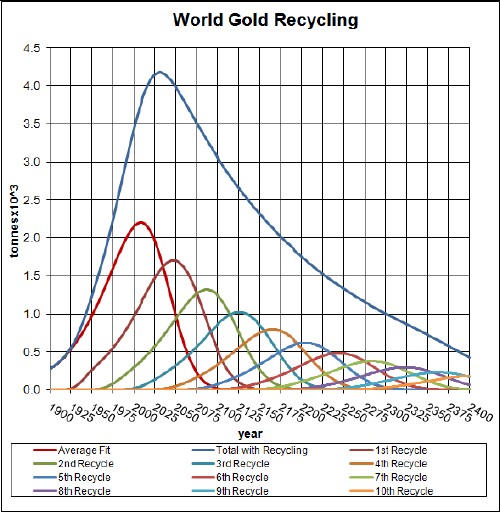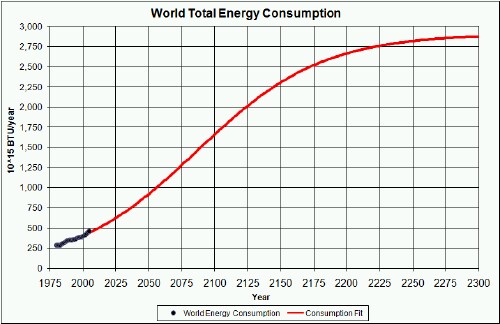Currency Systems Based on Energy Consumed
L. David Roper
http://www.roperld.com/personal/roperldavid.htm
03-May-2022
Contents
- Introduction
- Gold Standard Would Not Work
- Energy Standard
- Conclusion
Introduction
Most countries use a fiat currency system. That is, the items used for money have an intrinsic value that is much less than the value they represent in terms of goods and services they can buy. Most countries have their own currency, but many also allow United State fiat currency to be used, at least in some special circumstances, e.g., by tourists.
From 1945 until 1971 the United States currency was a representative currency rather than a fiat currency. One U.S. dollar represented 1/35 of a troy ounce (889 mg) of gold (gold standard). That is, the owner of a dollar was promised that it could be exchanged for 889 milligrams of gold. The United States changed to a fiat currency in 1971.
Some economists maintain that the inflation/deflation cycle (recessions and depressions) can never be controlled in a fiat currency system, because human decisions about controlling the money supply will never be perfect. Politics interferes too much into those decisions.
Some economists and politicians want the United States to change back to the gold-standard currency. The main problem with this is that there is a finite amount of gold in the Earth that can be mined without expending huge amounts of precious energy. Thus, at some point in time gold extraction will peak and then fall, eventually to near zero.
Why
a Gold Standard for a World Currency Would Not Work
For the following discussion assume that the U.S. dollar is the currency for the entire world and that it is fixed at a certain value in grams of gold; i.e., the $ is a representative currency using the gold standard. The following graph shows a rough estimate of the amount of gold that can be extracted in future years (red curve) and estimates ten cycles of recycling to yield the estimated blue curve for the total amount of extracted and recycled gold that would be available for each year.

So, if the blue curve is approximately correct and the dollar were set to a fixed amount of gold available each year, the number of dollars in circulation would peak at about year 2030 and then fall to zero at about year 2500. Obviously, this is not a good property for a representative currency to have.
The government department that sets the amount of the money supply might not know that the amount of available gold was decreasing; so, it would keep the money supply higher than it should be. If this continued far into the future, the so-called representative currency would, in effect, become a fiat currency.
An
Energy Standard for a World Currency
Apparently Buckminster Fuller was first in 1969 to recommend, in his book Operating Manual for Spaceship Earth, that a global currency be based on energy; he called it the "Kilowatt Dollar".
Petro-Dollar
More recently in 2005 a similar proposal was made in which a "Petro-dollar" was based on a set amount of energy, presumably energy gotten from burning petroleum. In 2009 a similar proposal was made to base a global currency on "exergy", energy delivered to consumers.
A currency based on energy obtained from petroleum has a similar problem as the one that occurs with a gold standard. A representative currency based on current energy use would fluctuate if non-renewable energy sources are not developed fast enough. Energy use, being mostly from fossil fuels, would peak at about 2025 and then fall off to some level of only energy use from renewable sources. (Nuclear energy will provide only a small fraction of the energy use.)

The number of dollars in circulation would peak at about year 2025 and then fall to zero at about year 2300. Obviously, this is not a good property for a representative currency to have.
Eco-Dollar
Perhaps a better proposal for an energy currency is the "Eco-Dollar" proposed in 2008, defined as 1-eco-dollar representing 1-kilowatt-hour of renewable energy (with a alteration by me since the proposal included non-renewable nuclear energy, which will be negligible). The problem with this is that only a small fraction of energy use now comes from renewable sources, so it currently is not a good basis for a representative currency.
Energy-Dollar
Of course, energy consumption by humans cannot grow indefinitely, because there is a limit to the amount of energy that can be captured from the Sun. The graph below shows the world energy-consumption data and a hyperbolic-tangent-function fit to the data in order to extrapolate into the future with an eventual asymptotic consumption amount of 350x106 BTU/year/person (~12 kW/person), for an assumed final asymptotic population of about 8.3x109. This is about the per-capita consumption of the United States now. This amounts to a consumption asymptote of about 2900x1015 BTU/year [2900 quad/year or (2900*1055)x1015 joules/year=3.06x1021 J/yr=9.69x1010 kilowatts]:

Currently the U.S. uses about 350x106 BTU/person (~12 kW/person), industrialized countries average about 200x106 BTU/person (~6.5 kW/person), developing countries average about 35x106 BTU/person (~1.2 kW/person) and the world average is about 75x106 BTU/person (~2.5 kW/person). The leveling off assumes that renewable energy sources will be developed in time to make the transition from the peaked fossil-fuels extraction curve to the smoothly rising energy-consumption curve.
Thus, a representative currency using energy consumption, for no energy-value inflation over time, would have an increasing supply of money that has the same slope as the energy-consumption curve. Currently the ratio of kilowatt-hours per dollar would be ([480x1015*1055/3.6x106]kilowatt-hours)/8.36x1012$ = ~17 kilowatt-hours/$, using the figure of 8.36x1012$ as the U.S. M2 money supply. At the asymptote the M2 value would be ~5.1x1013$ for a factor of ~6 total increase from now; which value would stay constant in future years.
The average price of energy would always be 1/17 $/kWh =~ $0.06/kWh; some energy will cost more and some will cost less because of the amount of energy required to provide energy from different sources will be different. For example, as crude oil becomes scarce its price will go up, but some renewable-energy prices will go down as the money supply is changed to keep the $ pegged at the fixed amount of energy.
The above calculations assume that M2 includes all U.S. money in the world; if the total $ world money supply is larger the numbers have to be changed to reflect that.
This approach to defining a representative currency based on energy consumption combines features of the two previously mentioned energy currencies (Petro-Dollar & Eco-Dollar): The dollar is pegged at a certain number of kWh of energy when the currency is established and stays at that value of kWh/$ from then on. The money supply changes as the amount of energy consumed changess. Initially the dollars are mostly Petro-Dollars; after fossil fuels are depleted renewable energy is the consumed energy, so the dollars are then Eco-Dollars.
Conclusion
It is possible to design a world representative currency system that is relatively inflation proof by pegging the value of the dollar to a certain amount of energy. The money supply would be changed at the same rate as energy is consumed.
References
- https://en.wikipedia.org/wiki/Currency
- https://en.wikipedia.org/wiki/Inflation
- https://www.bankrate.com/mortgages/inflation-housing-market/
L. David Roper, http://www.roperld.com/personal/roperldavid.htm;
roperld@vt.edu
L. David
Roper interdisciplinary studies